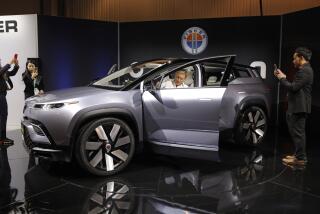In Autos, It’s Survival of the Biggest
- Share via
News reports on the automobile business contain hints of things to come--of which companies will survive the winnowing down to half a dozen global car makers, and which will not.
The news is that Saab, the Swedish auto maker, is reaching out to Ford for an alliance that will help it stay in the game. And that the West German government approves of a merger that could strengthen Mercedes-Benz by making it part of a giant company.
It may come as a surprise that even Mercedes, known around the world for its luxury cars, would have trouble making it unassisted in the competitive 1990s--but that’s the way it looks.
Consolidation in the auto industry has long been predicted--most notably by Giovanni Agnelli, the chairman of Italy’s Fiat, who said in the 1970s that ultimately there would be only five global car producers. Yet for a long time that prediction has looked foolish as more brands flooded the market. Today, according to the industry consultants J. D. Power & Associates, 16.5 million cars, light trucks and vans--in an incredible 350 different models--are produced or imported to supply the U.S. market. But only 14.6 million are being purchased, leaving an oversupply of roughly 2 million vehicles.
Can’t Be Too Big
That’s a competitive environment in which even haughty Mercedes and once-aloof Honda must give discounts to sell cars. It’s an environment in which some companies are losing money and a shakeout is inevitable, says analyst Charles Brady of Oppenheimer & Co., an investment firm.
What does that mean to you as a car buyer? It could mean “better cars at the same or lower prices,” says Brady, because what lies ahead is not a merger frenzy with big firms gobbling small, but a sharing of production and design costs in an attempt to appeal to customers of every taste, pocketbook and country.
What it means if you’re an investor is that an automobile company can’t be too big or too rich.
Because the cost of developing new products is enormous. Ford spent roughly $3.5 billion to design and develop its Taurus line. But Ford can do that because it spreads development costs over worldwide sales of 3.3 million vehicles and uses that basic design not only for the 350,000 Tauruses that it makes each year but also for Probes and Thunderbirds and Escorts, and Mercurys and Lincolns, too.
A producer such as Saab--making only 116,000 cars a year--has no similar opportunity to spread its costs and so can’t afford $3 billion to develop a new car. Thus, it is seeking an alliance in which it can share some costs with the big U.S. company and yet go on producing its cars in Sweden.
Well-Known Names
Ford already has several such alliances. It owns 25% of Japan’s Mazda and produces cars with Mazda in Michigan; it has a joint venture with Volkswagen in Brazil. In Europe, where Ford manufactures in seven countries, Saab may fit into its plans for a global car in which design work can be done on one continent and applied to automobiles produced on many continents.
Obviously, such an operation demands a global network for production, sales and service.
Obviously, too, a company without such a network will have higher costs and need help.
Car makers seeking alliances will include some well-known names. BMW--fewer than 500,000 cars a year--will need a partner; Saab’s Swedish neighbor Volvo, at roughly 300,000 cars, will need one, too. Such specialty producers as Jaguar and Porsche will need help. And Mercedes, which produces fewer than 600,000 vehicles a year, will need help in cars--notwithstanding whatever aid the big aerospace merger of Messerschmitt with its parent company Daimler-Benz can give the luxury auto producer.
Heading up alliances will be the industry’s giants: General Motors--still the world’s largest car maker at 5 million vehicles a year--and Toyota, now second with almost 4 million vehicles a year. Ford will be a leader, and probably so will Nissan, producer of more than 2 million cars and trucks.
Then come question marks, including Chrysler, which at 1.7 million vehicles--but with slender finances and few operations outside North America--may not be big enough to go it alone. And Chrysler Chairman Lee Iacocca may already recognize that.
Perhaps significantly, in the years since he brought Chrysler back from the dead, Iacocca has formed joint production ventures with Mitsubishi of Japan--which makes 1.2 million cars and trucks--and recently took on U.S. distribution of Fiat’s Alfa Romeo cars. His actions have led to speculation that ultimately, before his retirement in 1991, Iacocca will close the circle by placing Chrysler in a global alliance with Fiat and Mitsubishi.
That’s speculation, of course, but not so farfetched, given the demands of today’s car business. “The time will come,” says one car expert, “when the customer won’t know how many companies made the car he’s driving.” Nothing wrong with that so long as it gets good mileage and doesn’t break down on the road.






